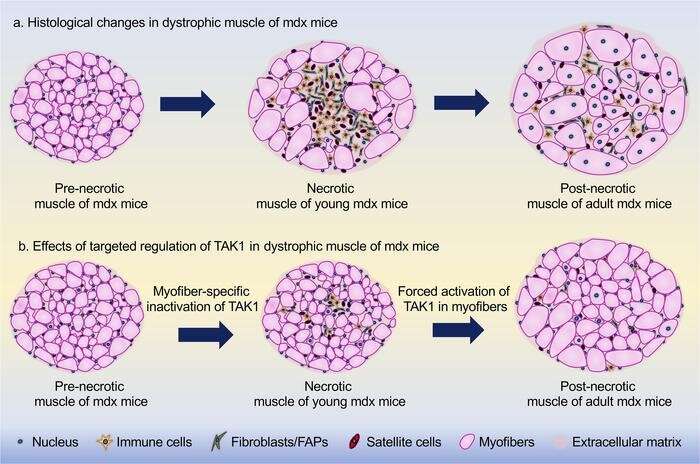This article has been reviewed according to Science X's editorial process and policies. Editors have highlighted the following attributes while ensuring the content's credibility:
fact-checked
peer-reviewed publication
trusted source
proofread
Researchers target protein that can slow down muscular dystrophy

A team of researchers at the University of Houston College of Pharmacy is reporting that by manipulating TAK1, a signaling protein that plays an important role in development of the immune system, they can slow down disease progression and improve muscle function in Duchenne muscular dystrophy (DMD).
DMD, caused by mutations in dystrophin gene, is an inheritable neuromuscular disorder that occurs in one out of 3,600 male births. DMD patients undergo severe muscle wasting, inability to walk and eventually death in their early thirties due to respiratory failure. The disease is marked by an inflammatory response and death of muscle fibers. Eventually, the muscle fibers are replaced with fat and fibrotic tissue that causes severe muscle weakness.
"Our results suggest that TAK1 (transforming growth factor β-activated kinase1) is a regulator of skeletal muscle mass. By specifically targeting this protein, we can suppress the death of muscle fibers, known as myonecrosis, and slow down disease progression in DMD," said Ashok Kumar, Else and Philip Hargrove Endowed Professor and chair, Department of Pharmacological and Pharmaceutical Sciences, whose results were published in JCI Insight.
"Our research shows that activating TAK1 can stimulate myofiber growth in a model of DMD, with no negative impact on muscle health."
In a previous breakthrough, Kumar's team uncovered a surprising fact: TAK1 is essential for maintaining skeletal muscle mass and that activating TAK1 beyond normal levels can enhance skeletal muscle growth.
For this research, the team designed experiments to reduce or augment the levels of TAK1 protein in skeletal muscle at different stages of disease progression.
"Our experiments demonstrate that depletion of TAK1 activity during peak necrotic phase followed by re-introduction of TAK1 at post-necrotic phase leads to substantial improvement in muscle pathology," said Anirban Roy, research assistant professor.
The current standard of care for DMD is focused on reducing inflammation with corticosteroids, which modestly reduces disease progression, but has serious side effects.
"Accumulating evidence suggests that regulation of immune response, autophagy, and metabolism along with gene correction therapy can be promising approaches to slow down disease progression in DMD patients," said Roy.
More information: Anirban Roy et al, Targeted regulation of TAK1 counteracts dystrophinopathy in a DMD mouse model, JCI Insight (2023). DOI: 10.1172/jci.insight.164768
















